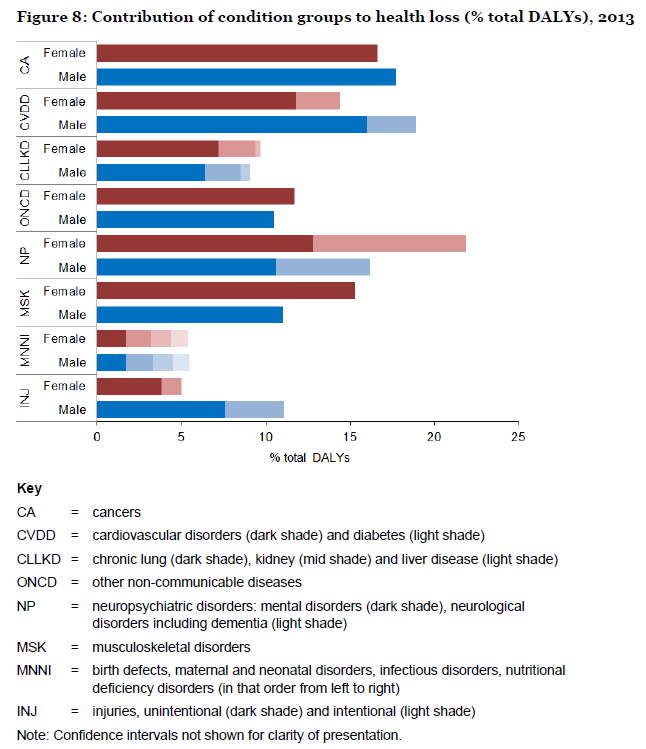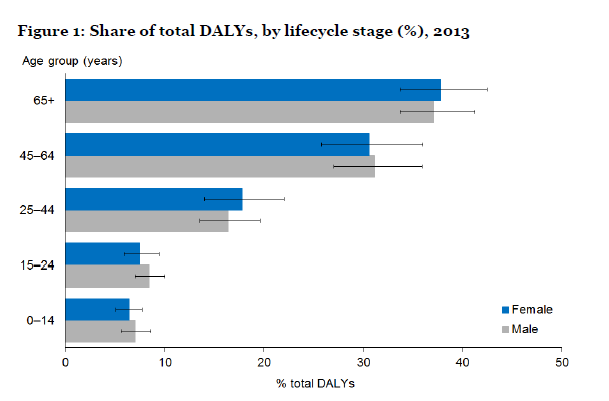In New Zealand, the Ministry of Health is using Global Burden of Disease (GBD) data to guide the country’s health strategy for the next 10 years and beyond.
An extensive new report, entitled Health Loss in New Zealand 1990-2013: A report from the New Zealand Burden of Diseases, Injuries, and Risk Factors, provides a big-picture look at New Zealand’s health landscape. By outlining the major causes of health loss in the country over the past two decades, it aims to guide policymakers, funders, researchers, and front-line providers in their efforts to ensure that all New Zealanders are “living well, staying well, and getting well.”
Drawing primarily on data from IHME’s GBD 2013 study, the report analyzes how much healthy life is lost to premature death, disease, and disability across all ages and both sexes. This comprehensive metric of health loss – the disability-adjusted life year (DALY) – is crucial for illustrating not just quantity of life but also quality of life, something the report flags as particularly important given New Zealand’s increasing burden of long-term mental and physical conditions and a rapidly aging population. It also examines the contribution of different risk factors to this health loss.
Figure 1: Contribution of condition groups to health loss (% total DALYs), 2013

Source: Health Loss in New Zealand 1990-2013: A report from the New Zealand Burden of Diseases, Injuries, and Risk Factors
Data like these provide decision-makers with key insights that will help them set priorities and design policy. While overall, people in New Zealand are living longer and it has achieved one of the fastest declines in health loss among high-income countries, some crucial challenges still remain. This report demonstrates, for example, that emphasis should be placed on increasing the capacity of New Zealand’s health system to effectively treat people with multiple long-term illnesses, given that over 88% of its disease burden is attributable to chronic diseases that often present together and complicate each other. Prevention is also a key part of this picture, particularly given the importance of keeping younger generations healthy as they age. The report’s authors estimate that up to one-third of health loss in New Zealand could be averted through reducing people’s exposure to risk factors, suggesting that investments in prevention – especially when it comes to leading risk factors such as poor diet, obesity, and smoking – could deliver major improvements in people’s health.
Figure 2: Health loss caused by selected risk factors (% total DALYs), 2013

Source: Health Loss in New Zealand 1990-2013: A report from the New Zealand Burden of Diseases, Injuries, and Risk Factors
The report also highlights the fact that while health in New Zealand is generally improving, not everyone is benefitting equally and there are still stark differences along the lines of gender, age, ethnicity, and socioeconomic status. GBD data help to illuminate some of these inequities. For instance, while older generations have the greatest share of DALYs overall, the rate of reduction in DALYs is actually slowest among youth and young adults. Additionally, neuropsychiatric disorders such as depression, anxiety, and dementia are the leading cause of DALYs for the country as a whole, but they are a more significant source of health loss for women than for men; conversely, men suffer much higher rates of health loss from injuries. Starting in 2016, GBD data for New Zealand will also include an analysis of the burden of disease among Maori and non-Maori populations. Access to crucial information like this allows decision-makers to target resources and services where they are needed most.
New Zealand’s Director-General of Health, Chai Chuah, emphasizes the value of having a comprehensive and comparable dataset that outlines the country’s major health challenges, noting in the report’s foreword that it “gives all in the sector a common evidence base on which to build our response to these challenges as one team.” Though the report was published only recently, in August 2016, the Ministry of Health is already planning for future iterations and will collaborate directly with IHME to ensure that GBD data are used as effectively as possible. “This broad picture of health loss, and its regular updates, will continue to inform decisions on resource allocation, priority setting, and investment in health services and prevention programs” writes Mr. Chuah, exemplifying New Zealand’s strong commitment to using burden of disease data to improve its population’s health.